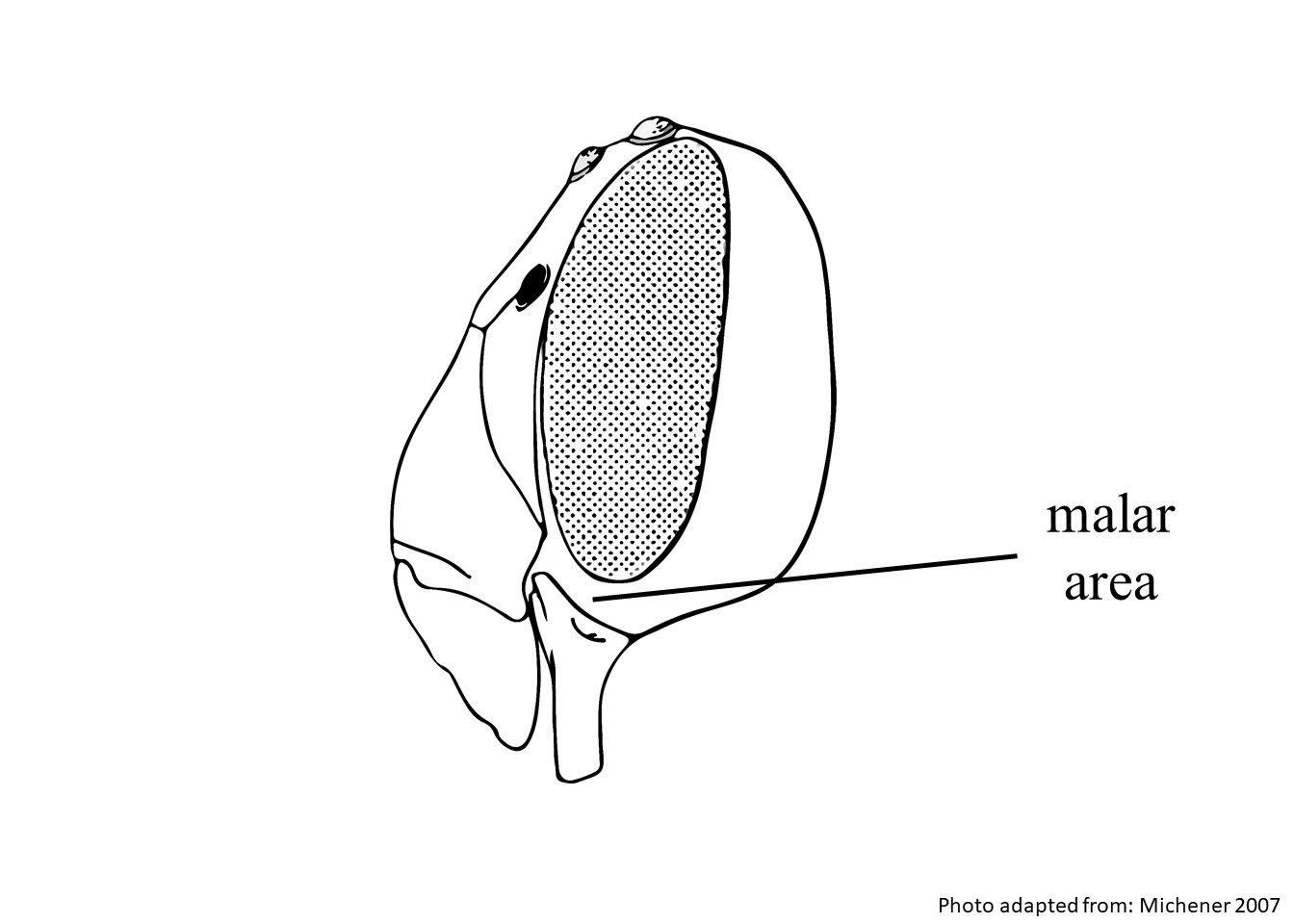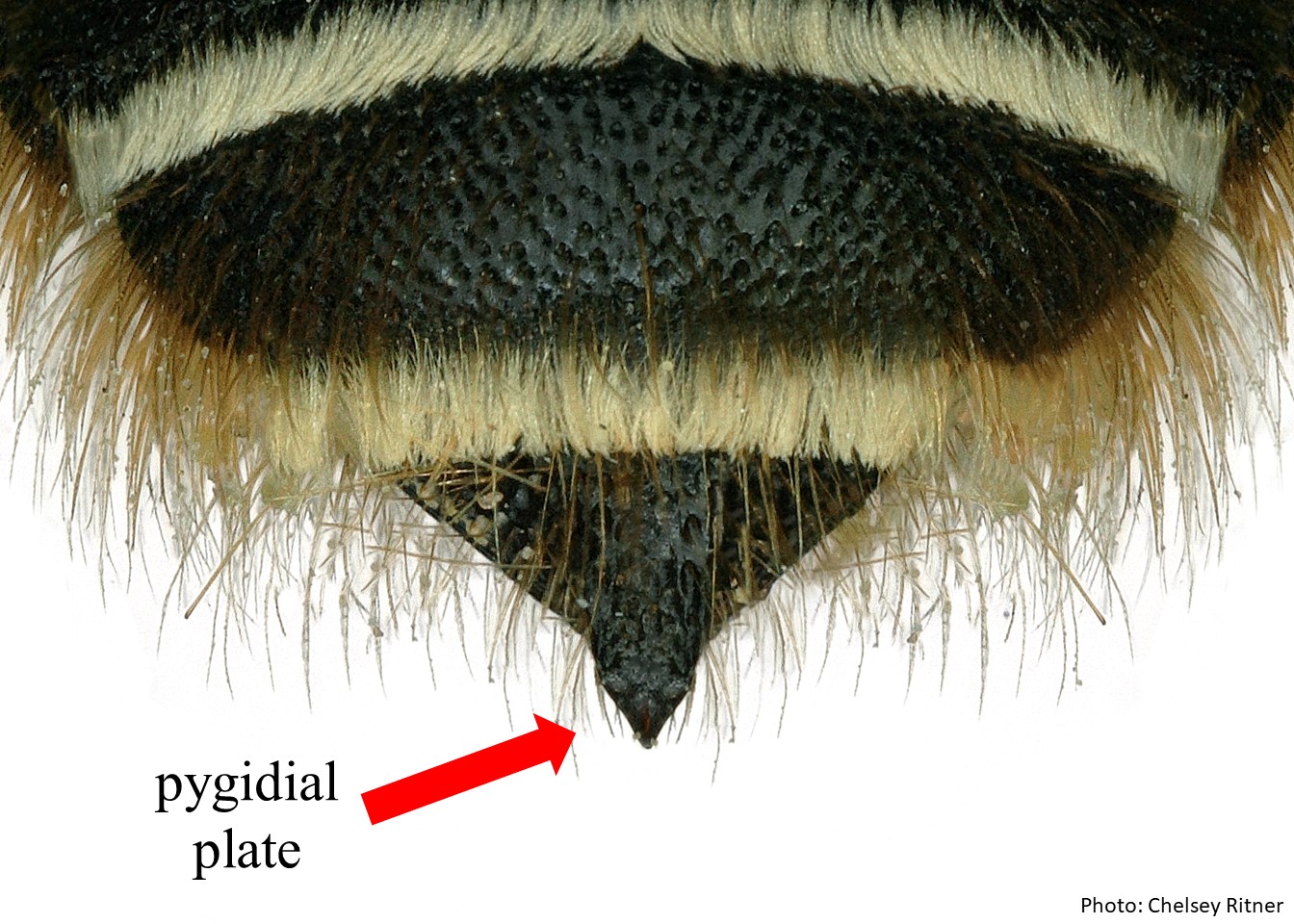Family: Apidae
Subfamily: Xylocopinae
Tribe: Xylocopini
Genus: Xylocopa
Subgenus: Schonnherria, Lepeletier 1841
Common name: Carpenter bee
Xylocopa (Schonnherria) are medium sized bees, 14 – 23 mm in length, with dark blue, green, gold, or black integumentintegument:
a tough, protective outer layer
, often with vibrant metallic reflections (Hurd and Moure 1963Hurd and Moure 1963:
Hurd, P.D. and J.S. Moure. 1963. A Classification of the Large Carpenter Bees (Xylocopine) (Hymenoptera: Apoidea). University of California Publications in Entomology (Vol. 29). Berkeley and Los Angeles: University of California Press, 365 pp.; Villamizar et al. 2020Villamizar et al. 2020:
Villamizar, G., F. Fernaacute;ndez, and F. Vivallo. 2020. Synopsis of the carpenter bee subgenus Xylocopa (Schonnherria) Lepeletier, 1841 (Hymenoptera: Apidae) in Colombia, with designation of lectotypes and the description of two new species. Zootaxa 4789(2): 301-347.). They have short pubescencepubescence:
short, fine hair
that can range from black to pale. Their wings are a light brown color and have a very weak yellow or violet iridescent color (Hurd 1978Hurd 1978:
Hurd, P.D. 1978. An Annotated Catalog of the Carpenter Bees (Genus Xylocopa Latreille) of the Western Hemisphere (Hymenoptera: Anthophoridae). Smithsonian Institution Press, Washington D.C. 106 pp.).
Xylocopa (Schonnherria) contains 31 species (Hurd 1978Hurd 1978:
Hurd, P.D. 1978. An Annotated Catalog of the Carpenter Bees (Genus Xylocopa Latreille) of the Western Hemisphere (Hymenoptera: Anthophoridae). Smithsonian Institution Press, Washington D.C. 106 pp.; Michener 2007Michener 2007:
Michener, C.D. 2007. The Bees of the World (2nd ed.). Johns Hopkins University Press, Baltimore and London, 953 pp.; Villamizar et al. 2020Villamizar et al. 2020:
Villamizar, G., F. Fernaacute;ndez, and F. Vivallo. 2020. Synopsis of the carpenter bee subgenus Xylocopa (Schonnherria) Lepeletier, 1841 (Hymenoptera: Apidae) in Colombia, with designation of lectotypes and the description of two new species. Zootaxa 4789(2): 301-347.).
Xylocopa (Schonnherria) occurs from northern Argentina and Chile up north to the southern United States, and then along the coast from Texas to Florida to Virginia (Michener 2007Michener 2007:
Michener, C.D. 2007. The Bees of the World (2nd ed.). Johns Hopkins University Press, Baltimore and London, 953 pp.).

Distribution map generated by Discover Life -- click on map for details, credits, and terms of use.
Xylocopa (Schonnherria) generalist pollinators and have been observed visiting the flowers of a number of plant families including Acanthaceae, Anacardiaceae, Apocynaceae, Aquifoliaceae, Arecaceae, Asteraceae, Bignoniaceae, Bixaceae, Caprifoliaceae, Convolvulaceae, Ericaceae, Fabaceae, Lamiaceae, Lythraceae, Malvaceae, Nyctaginaceae, Ochnaceae, Oleaceae, Onagraceae, Orchidaceae, Passifloraceae, Plantaginaceae, Polygalaceae, Ranunculaceae, Rosaceae, Rubiaceae, Sapindaceae, Scrophulariaceae, Solanaceae, Surianaceae, Polygonaceae, Verbenaceae, and Zygophyllaceae (Hurd 1978Hurd 1978:
Hurd, P.D. 1978. An Annotated Catalog of the Carpenter Bees (Genus Xylocopa Latreille) of the Western Hemisphere (Hymenoptera: Anthophoridae). Smithsonian Institution Press, Washington D.C. 106 pp.).
(modified from Hurd and Moure 1963Hurd and Moure 1963:
Hurd, P.D. and J.S. Moure. 1963. A Classification of the Large Carpenter Bees (Xylocopine) (Hymenoptera: Apoidea). University of California Publications in Entomology (Vol. 29). Berkeley and Los Angeles: University of California Press, 365 pp. and Minckley 1998Minckley 1998:
Minckley, R. L. 1998. A Cladistic Analysis and Classification of the Subgenera and Genera of the Large Carpenter Bees, Tribe Xylocopini (Hymenoptera: Apidae). Natural History Museum, The University of Kansas 9: 1-47.)
 short.
short. and absent on the remaining tergaterga:
and absent on the remaining tergaterga: .
. with subapicalsubapical:
with subapicalsubapical:X. (Schonnherria) often stand out because of their brightly metallic integumentintegument:
a tough, protective outer layer
. They can be distinguished from other New WorldNew World:
the Western Hemisphere; especially the continental landmass of North and South America
subgenera by the apicallyapically:
near or at the apex or end of any structure
bifid gonostylusgonostylus:
the apical-most appendage of the male genitalia, which is usually quite hairy
in the males and the females with gradulusgradulus:
A transverse line on abdominal segments of some bees that is formed by a groove or a step between two regions that differ in height. This line can be well developed and present across the entire segment but can also be diminished or absent through part of the segment, requiring close inspection.
present on T1T1:
the segments on the top side of the abdomen, often abbreviated when referring to a specific segment to T1, T2, T3, T4, T5, T6, or T7 but no other tergaterga:
but no other tergaterga:
the segments on the top side of the abdomen, often abbreviated when referring to a specific segment to T1, T2, T3, T4, T5, T6, or T7 (Minckley 1998Minckley 1998:
(Minckley 1998Minckley 1998:
Minckley, R. L. 1998. A Cladistic Analysis and Classification of the Subgenera and Genera of the Large Carpenter Bees, Tribe Xylocopini (Hymenoptera: Apidae). Natural History Museum, The University of Kansas 9: 1-47.).
Xylocopa (Schonnherria) nests in dead wood, including woods from the genera Eucalyptus, Ligustrum, Poaceae, Populus, Robinia, Salix, and Sweetia, (Hurd 1978Hurd 1978:
Hurd, P.D. 1978. An Annotated Catalog of the Carpenter Bees (Genus Xylocopa Latreille) of the Western Hemisphere (Hymenoptera: Anthophoridae). Smithsonian Institution Press, Washington D.C. 106 pp.).
There are no known invasives.
Hurd, P.D. and J.S. Moure. 1963. A Classification of the Large Carpenter Bees (Xylocopine) (Hymenoptera: Apoidea). University of California Publications in Entomology (Vol. 29). Berkeley and Los Angeles: University of California Press, 365 pp.
Hurd, P.D. 1978. An Annotated Catalog of the Carpenter Bees (Genus Xylocopa Latreille) of the Western Hemisphere (Hymenoptera: Anthophoridae). Smithsonian Institution Press, Washington D.C. 106 pp.
Michener, C.D. 2007. The Bees of the World (2nd ed.). Johns Hopkins University Press, Baltimore and London, 953 pp.
Villamizar, G., F. Fernández, and F. Vivallo. 2020. Synopsis of the carpenter bee subgenus Xylocopa (Schonnherria) Lepeletier, 1841 (Hymenoptera: Apidae) in Colombia, with designation of lectotypes and the description of two new species. Zootaxa 4789(2): 301-347.